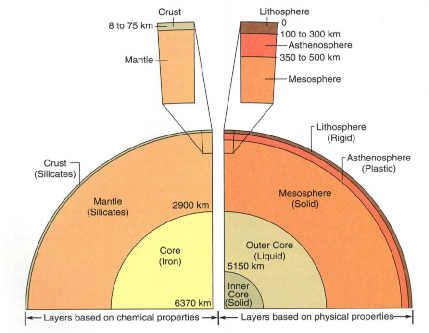Table 3.1
Name of the Layer | Chemical Composition | Depth | Density | Physical Property |
A. Crust | Crustal material | 5-70 Km. | Solid State | |
1. Upper SIAL | contains lighter elements like Si, | |||
2. Lower SIMA | O, Al, Ca, K, Na, etc... Feldspars | |||
(Anorthite, Albite, Orthoclase) are common | 2.75 – 2.90 | |||
minerals in the crust | ||||
(CaAL2Si2O8, NaALSi3O8, | ||||
KALSi3O8). | ||||
B. Mantle | is made up of Si and O, like the | 35-2900 | Some properties of | |
3. upper mantle (From | crust, but it contains | km. | solid, some plastic. | |
Moho to 410 km) | more Fe and Mg. Thus, Olivine | Near the melting point | ||
4. transition zone (410– | (Fe2SiO4-Mg2SiO4) and pyroxene | 3.4-5.6 | their behavior is like | |
660 km), | (MgSiO3-FeSiO3) | solids heavy | ||
5. lower mantle (660– | are abundant in the mantle | |||
2891 km) |
C. Metallic Core of Barysphere 6. Outer Metallic Core 7. Inner Metallic Core | NIFE (Nickel + Ferrous or Iron) Barysphere (Heavy Metallic rocks) | 2900 – 5150 km 5150 – 6378 km | 5.10 – 13.00 | Liquid or in plastic state Rigid because of tremendous overlying pressure |
4. Crust and Mantle vs. Lithosphere and Asthenosphere
Lithosphere, asthenosphere, and mesosphere represent changes in the mechanical properties of the Earth. Crust, Mantle and Core refer to changes in the chemical composition of the Earth.
The lithosphere (litho: rock; sphere: layer) is the strong, upper 100 km of the Earth. The lithosphere is the tectonic plate (we talk about it in plate tectonics). The asthenosphere (asthenos: weak) is the weak and easily deformed layer of the Earth that acts as a “lubricant” for the tectonic plates to slide over. The asthenosphere extends from 100 km depth to 660 km beneath the Earth's surface. Beneath the asthenosphere is the mesosphere, another strong layer.

.
